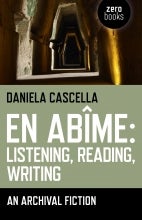Book Review: "En Abîme: Listening, Reading, Writing"

En Abîme: Listening, Reading, Writing: An Archival Fiction. By Daniela Cascella. Zero Books, 2012. $16.95. enabime.wordpress.com
Reviewed by Lola San Martín Arbide, University of Salamanca, Spain.
Throughout En Abîme: Listening, Reading, Writing: An Archival Fiction, the reader will find a repeated confession by the author, Daniela Cascella: “I lost all of my strength, I lost my ability.” This literary leitmotif is the true raison d’être of the text, to stick with the French in the title. En Abîme, a collection of Cascella’s criticism, resulted from an effort to put together a scattered body of work. As she has explained in interviews, the selected fragments have been extracted from a private notebook written concurrently with the press articles she published between 1998 and 2011. A type of counterpoint was created between these two parts, especially as the former are often more poetic, inventive, and personal than the latter. Books read in the past inform the way we listen, hear, and feel, and this creates a special kind of sound map, which in turn can develop into an intimate mental panorama. Cascella takes the reader for a walk through her inner landscape.
Embracing this concept of inscape, the author grants us access to her personal approach to writing sound. “Call me a writer of sound,” she writes. It is her inscape that sets the mood, the ethos for each piece. As if writing were the “other side of sound,” Cascella explores the ways that listening, reading, and writing are so closely imbricated. She explains this connection through her personal experience bringing together memories about the sound of novels by Herman Melville or traditional Alpine songs and linking them to actual places in Rome. Listening, sound, memories; these are concepts often considered too abstract to attempt to define normatively. However, Cascella’s book is an example of the concrete way that the three concepts are actually applied in the process of creative writing. She is an example of the listening art historian, to whom synesthesia, or “cohabitation of worlds” as she terms it, is the required medium towards any sort of artistic initiative.
The narration itself is a literal mise-en-abîme, employing repetition as one of its most distinctive stylistic characteristics. Extracts from quoted writers and musicians such as Pier Paolo Pasolini, Giovanna Marini, and Carlo Emilio Gadda, appear frequently in varied versions, creating a feeling of closeness to the author and to the story being told. All of these fragmentary elements, which appear scattered at the beginning, are emotively tied up in the end. The quoted artists are the elements of the subjectively crafted landscape in which Cascella’s literary criticism texts are rooted. These memories and personal stories exemplify the ways in which the cultural wealth accompanying our lives is an ever-changing corpus of potentially artistic materials. Despite the number of visual elements present throughout the text, there is not a single reproduction of them. This enhances a deeper sense of “archival fiction” and sets an ambiance where abstract reflection takes over from the precise and descriptive analysis typical of traditional research.
Most libraries will classify this book under the general title of “literary criticism” as it does not quite fit into the standard tag of “music” or even that of “sound studies.” Elegantly leaving aside the style of academic writing, which tends to favor linear discourse, these fragments of a self-ethnography are of great interest when analyzed in terms of bilingualism. Writing in a foreign language for the sake of the sound of it – its natural melody, intonation, and pronunciation – must have been a beautiful and pleasurable challenge for the author. The book is set in a middle ground between a vernacular style and that of an adopted tongue, which calls for a renewed musical attitude from the native English-speaking reader. Cascella defines sound art as the “non-canonized way of shaping listening,” whereas En Abîme might well be described as a non-canonized subgenre of autobiography. It is a journey into Cascella’s ability to explain her artistic sensibility and part of her professional life in terms of past experiences, re-visited places, and artworks.
Drawing on examples such as John Cage’s dissemination of Thoreau’s diaries until his words were nothing but abstract sounds, Cascella shows how sonic experiences become a shivering body, a rhythm that finds parallels in literary, filmic, or visual experiences. The book calls for a highly synesthetic sensibility from the art critic and writer. This approach can be of equal value to the ethnographer as well as to any kind of researcher. In general terms, Cascella is defending a broad approach to humanities, a holistic consideration of any art piece. The mise-en-abîme comes in when the reader is confronted with the assertion that a critique of an art piece is also subject to yet another critique, which in turn is subject to another in an endless repetition of critique. By making public our opinions and thoughts on what other people created, we are equally exposing our own creativity and its background. Cascella’s work seems to suggest that the best attitude a researcher can embrace is to acknowledge subjectivity, as long as clarity and honesty about its sources prevail. Quoting Jean Luc Godard, what matters “is not where you take things from, it’s where you take them to.”





